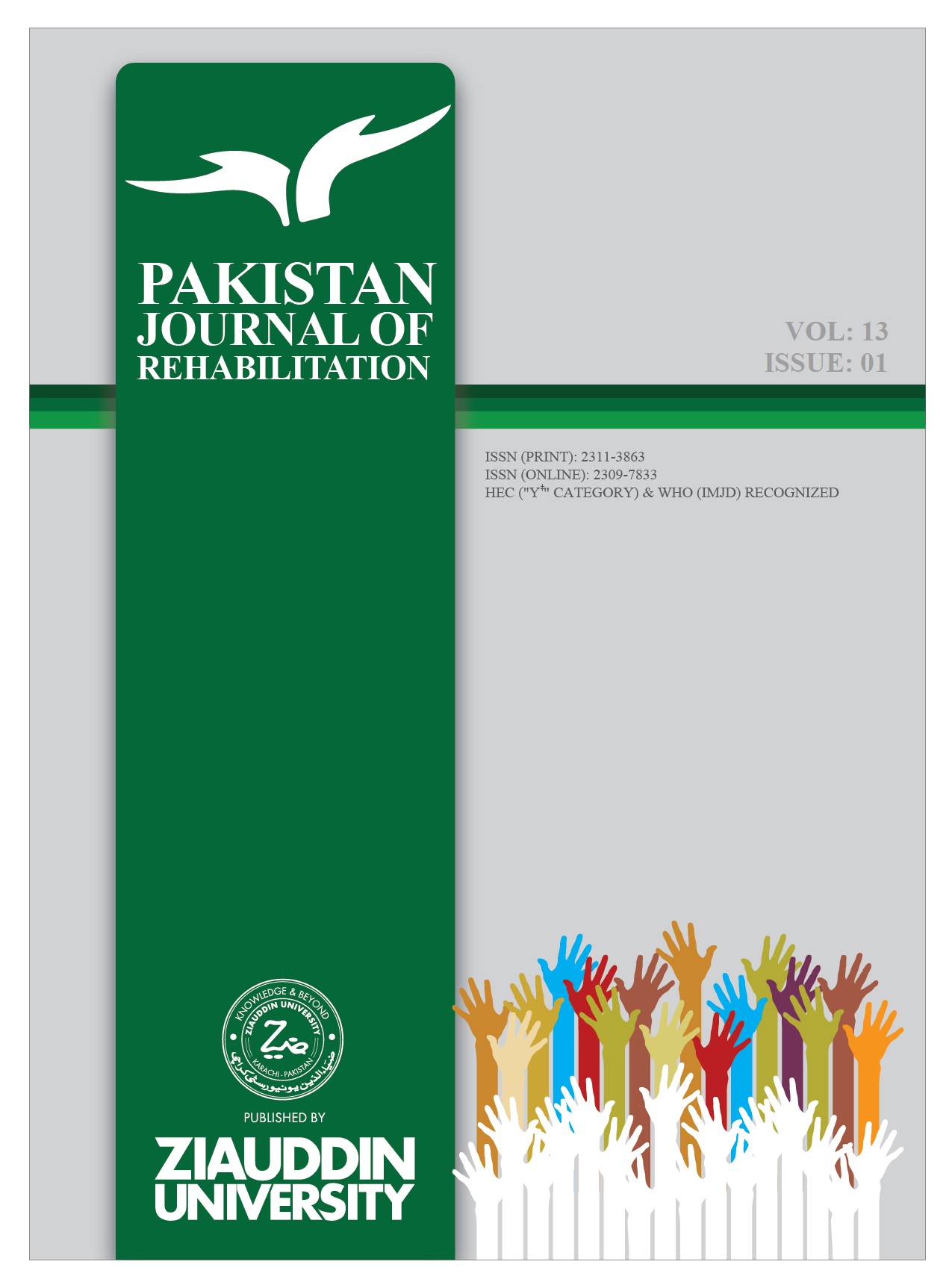GENDER DIFFERENCE IN FUNCTIONAL DISABILITY AMONG PATIENT WITH NON-SPECIFIC CHRONIC LOW BACK PAIN
Keywords:
Functional disability, Non-specific, Sex factor, quality of life, gender identity, low back painAbstract
Background of the Study: LBP is a common condition that can be specific or non-specific. Non-specific LBP, which has no known cause, is responsible for 90% of cases and causes pain in the back from the 12th rib to the inferior gluteal folds.
Methodology: The study utilized a cross-sectional design in which both males and females completed the Oswestry low back questionnaire. The data was entered and analyzed using SPSS version 21.
Results: 85 patients participated in the study with a mean age of 38±9.603. Pain levels varied among patients, with 23 reporting no pain, 29 with light pain, 23 with moderate pain, and 10 with pretty severe pain. Patients had varying degrees of self-care ability with 13 able to care for themselves without triggering pain and 4 requiring daily assistance. Most patients (75 out of 85) had minor disabilities, while 10 had moderate disabilities. The relationship between the ODI score and the question was found to be similar.
Conclusion: The data suggest that individuals with non-specific chronic low back pain have only a limited impairment, and only a few suffer from moderate sickness that affects their social lives. Non-specific persistent low back pain is not connected with gender differences in functional impairment.
References
Illes ST. Low back pain: when and what to do. Orvosi hetilap. 2015;156(33):1315-20.
Lee H, Hübscher M, Moseley GL, Kamper SJ, Traeger AC, Mansell G, et al. How does pain lead to disability? A systematic review and meta-analysis of mediation studies in people with back and neck pain. Pain. 2015;156(6): 988-97.
Global, regional, and national incidence, prevalence, and years lived with disability for 328 diseases and injuries for 195 countries, 1990-2016: a systematic analysis for the Global Burden of Disease Study 2016. Lancet (London, England). 2017;390(10100): 1211-59.
Wu A, March L, Zheng X, Huang J, Wang X, Zhao J, et al. Global low back pain prevalence and years lived with disability from 1990 to 2017: estimates from the Global Burden of Disease Study 2017. Annals of translational medicine 2020;8(6).
Hartvigsen J, Hancock MJ, Kongsted A, Louw Q, Ferreira ML, Genevay S, et al. What low back pain is and why we need to pay attention. The Lancet. 2018;391(10137):2356-67.
Wu A, Dong W, Liu S, Cheung JPY, Kwan KYH, Zeng X, et al. The prevalence and years lived with disability caused by low back pain in China, 1990 to 2016: findings from the global burden of disease study 2016. Pain. 2019;160(1):237.
Wáng YXJ, Wáng J-Q, Káplár Z. Increased low back pain prevalence in females than in males after menopause age: evidences based on synthetic literature review. Quantitative imaging in medicine and surgery. 2016;6(2): 199.
Rahyussalim AJ, Zufar MLL, Kurniawati T. Significance of the association between disc degeneration changes on imaging and low back pain: a review article. Asian spine journal. 2020;14(2): 245.
Wáng Y-XJ. Continued progression of lumbar disc degeneration in postmenopausal women. Climacteric. 2015;18(3): 435.
Maher C, Underwood M, Buchbinder R. Non-specific low back pain. The Lancet. 2017;389(10070): 736-47.
Alexander CE, Sandean DP, Varacallo M. Lumbosacral facet syndrome. 2017.
AlShayhan FA, Saadeddin M. Prevalence of low back pain among health sciences students. European Journal of Orthopaedic Surgery & Traumatology 2018;28(2):165-70.
Hoy DG, Smith E, Cross M, Sanchez-Riera L, Blyth FM, Buchbinder R, et al. Reflecting on the global burden of musculoskeletal conditions: lessons learnt from the global burden of disease 2010 study and the next steps forward. Annals of the rheumatic diseases 2015;74(1): 4-7.
Chang DG, Holt JA, Sklar M, Groessl EJ. Yoga as a treatment for chronic low back pain: A systematic review of the literature. Journal of orthopedics & rheumatology 2016;3(1): 1.
Arnbak B, Jensen TS, Egund N, Zejden A, Hørslev-Petersen K, Manniche C, et al. Prevalence of degenerative and spondyloarthritis-related magnetic resonance imaging findings in the spine and sacroiliac joints in patients with persistent low back pain. European radiology 2016;26(4):1191-203.
Gordon R, Bloxham S, editors. A systematic review of the effects of exercise and physical activity on non-specific chronic low back pain. Healthcare, Multidisciplinary Digital Publishing Institute 2016; 4(2):22.
Parvez M, Rahman A, Tasnim N. Ergonomic mismatch between students anthropometry and university classroom furniture. Theoretical Issues in Ergonomics Science. 2019;20(5):603-31.
Hussain SM, Urquhart DM, Wang Y, Dunstan D, Shaw JE, Magliano DJ, et al. Associations between television viewing and physical activity and low back pain in community-based adults: a cohort study. Medicine 2016;95(25).
Zahra NAI, Sheha E, Elmoaty Elsayed H. Low back pain, disability and quality of life among health care workers. Int J Pharm Res Allied Sci 2020;9(2): 34-4.
Mohamed IT, Kandil OA, Mohammed MM, Abd Elmageed SF. Prevalence of low back pain among physical therapists in Cairo-Egypt. International Journal of Therapies and Rehabilitation Research 2017;6(4):21.
Al-Shareef AT, Omar MT, Ibrahim AH. Effect of kinesio taping on pain and functional disability in chronic nonspecific low back pain. Spine 2016;41(14):821-8.
Fernandes JAA, Genebra CVdS, Maciel NM, Fiorelli A, Conti MHSd, De Vitta A. Low back pain in schoolchildren: a cross-sectional study in a western city of São Paulo State, Brazil. Acta ortopedica brasileira 2015;23:235-38.
Zhang Y, Tang S, Chen G, Liu Y. Chinese massage combined with core stability exercises for nonspecific low back pain: a randomized controlled trial. Complementary therapies in medicine 2015;23(1):1-6.
Kanas M, Faria RS, Salles LG, Sorpreso ICE, Martins DE, Cunha RAd, et al. Home-based exercise therapy for treating non-specific chronic low back pain. Revista da Associação Médica Brasileira 2018;64:824-31.
Meints SM, Wang V, Edwards RR. Sex and race differences in pain sensitization among patients with chronic low back pain. The Journal of Pain 2018;19(12):1461-70.

Additional Files
Published
How to Cite
Issue
Section
License
Copyright (c) 2024 Pakistan Journal of Rehabilitation

This work is licensed under a Creative Commons Attribution 4.0 International License.



